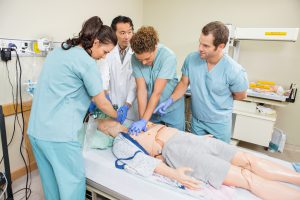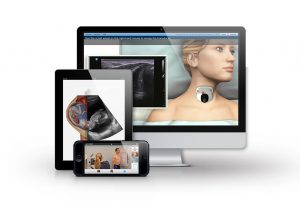Textbooks and videos give access to an array of knowledge, from theory to practical facts. When paired with good instructors and learning environments, they provide a strong foundation of information to help students on their journey to prepare for real-world medical scenarios. But learning in a conventional classroom can only go so far, and real-life clinical experience is critical. Yet that type of training is often hard to access and includes risks.
The exciting thing is that with today’s digital technology and advanced simulation equipment, it’s possible to take medical learning to an entirely new level that benefits both student and faculty, and ultimately the patient.
Where Traditional Learning Techniques Fall Short
Despite the timeless value of the traditional college or university setting, or even online classes for that matter, traditional teaching and learning methods are limited and just can’t compare to hands-on experience. This is particularly true in the medical field where many students have to move straight “from paper to patient” with minimal opportunity for real-life practice in between.
Take learning how to perform a procedure like venipuncture, for example. Medical students pore over information and checklists in their textbooks. Their instructors provide videos and slideshow presentations for further detail. From there, educators demonstrate the procedure, adding in their own real-world experience for reinforcement.
Thankfully, many students today have an opportunity to practice the venipuncture procedure on static task trainers and plastic arms during limited blocks of time prior to their clinicals. This is extremely helpful but there remains a downside.
At some point, to perform venipuncture you do have to insert a real needle into a real patient’s arm, but how can the instructor be certain that their students are properly ready to move on to that important stage? And the learners themselves also need to have confidence that they are ready!
With phlebotomy being one of the most basic, and usually harmless, procedures covered in premed and many allied health classes, students learning this skill may be allowed to practice on each other after signing a number of waivers. Yet, even that has its risks if a student is struggling with the procedure – for instance, classmates not wanting that person to practice taking blood from their arms!
In summary, students can watch videos and slideshows, view textbooks and answer endless quizzes, but these are essentially passive activities. There is no way to measure competence in the skill being learned. (Quizzes test theoretical knowledge, but not procedural competence.) Practicing in a lab is a significant step forward, but it requires an expert to observe and assess every single student’s competence, which often needs to be repeated multiple times for students who do not pass on the first attempt.
What if there was a step in between, a way of measuring some level of competence before the final check-off in the lab?
Simulation in medical education offers the solution – acting as the bridge between “knowing about” and “doing correctly”.
Exploring the Growing World of Medical Simulation
Simulation-based training has been in use for many years in certain industries. From flight simulators and CAD drawing to astronaut training, students and apprentices have been able to use varying degrees o f interactive simulations to better prepare them for their chosen careers. Early on in the field of medical education, there were rudimentary forms of simulation like using pigskin and fruit when learning certain types of procedures. Eventually, simulation technology began to be adopted, and medical simulators are now available in numerous forms.
f interactive simulations to better prepare them for their chosen careers. Early on in the field of medical education, there were rudimentary forms of simulation like using pigskin and fruit when learning certain types of procedures. Eventually, simulation technology began to be adopted, and medical simulators are now available in numerous forms.
Starting with the Basics: At the most fundamental level, med students have online medical training apps at their disposal. They’re able to work through standard lessons and apply what they learn via a few finger taps or mouse clicks. This can be helpful in an array of training situations, like proper AED use, recognition of instruments, or fun surgery games.
Moving Forward: In some medical schools, students combine virtual and online learning with real-time training. They work with real medical equipment plus training resources such as bench-top trainers and fake arms to practice skills like phlebotomy. But this type of simulation equipment has its own limitations: it is only available in a specific location and at specific times, when instructors are available, and according to the schedule of classes that need share the same training center.
This is where purely digital products, like SIMTICS medical simulations, can provide huge benefits. SIMTICS specializes in virtual simulation of medical procedures and ultrasound assessments, enabling students to prepare effectively for clinical tasks they’ll perform in the real world. All of this can take place on a laptop or mobile device that the student can access anywhere and anytime – right at the learner’s fingertips.
Unlike a standalone video or a quiz, the SIMTICS simulation-based system guides the student step by step through each procedure they need to learn so they can achieve “cognitive competence”. This answers the question: can the student demonstrate online that they know how to perform this procedure safely and correctly?
SIMTICS keeps records of each action performed during simulated exercises, so students can review and learn from their mistakes without using equipment and consumables, and without placing classmates or patients at risk. Each student can learn at their own pace. They can repeat simulations as needed and drill into sections of a procedure that they struggle with. This creates an equitable situation for all students, no matter their background.
Instructors can check logbook data to verify when each student has reached the required level of competence in the simulated procedure, before they are allowed to perform it in real life.
Mastering Complexity: During the latter stages of a medical education program, simulation-based training is often taken even further. Today’s AI and microelectronics have brought about a new breed of high-end mannequins for medical training. They can mimic pulses, breathing, heart tones and other vital signs to provide real-time information as students assess and react to the simulated patient. This type of mannequin is as close to a living patient as it gets and can be used to simulate the full range of medical situations, from routine hospital rounds to emergency situations. Students get to “practice on plastic” before they do it in real life. 
Combine these mannequins with a realistic clinical scenario, access to medical equipment, a simulation center set up like a hospital room or operating theater, technicians to run the scenarios, plus well-rehearsed “actors”, and it’s a super-powerful learning experience. Not forgetting the need to schedule the right students to be in the right place at the right time and completing the all-important debriefing session with preceptors afterwards. Yes, there’s a lot of cost and effort involved in this type of high-end simulation!
In summary, all these simulation options provide an interactive, engaging learning experience for students with each level of training being more life-like than the one before.
The Bottom Line
In industries like computing and accounting, being ushered straight from the classroom to the workplace is unlikely to be harmful. Mistakes can be easily corrected long before they become a problem. That’s definitely not the case in the medical field where errors stemming from lack of experience or poor competence can be deadly. Literally!
Simulators for medical training address this issue. They provide critical practice opportunities for students to build confidence and confidence before they go near a real patient.
Thanks to the pioneering work of companies like SIMTICS and simulation equipment manufacturers, simulation technology is not only far more advanced today, but more widely available to medical and allied health students. And a digital product like SIMTICS makes medical procedure simulation affordable for individual learners and allied health schools, not just for well-funded simulation centers at universities and hospitals.
Medical simulations are undoubtedly the future of healthcare training and can be used for virtually every phase of the educational process. All stakeholders – students, faculty and patients – can benefit greatly from this type of technology.
If you’re a medical or allied health educator or student, check out SIMTICS today to see how you can put our suite of simulation-based learning modules to work for you!





